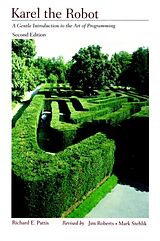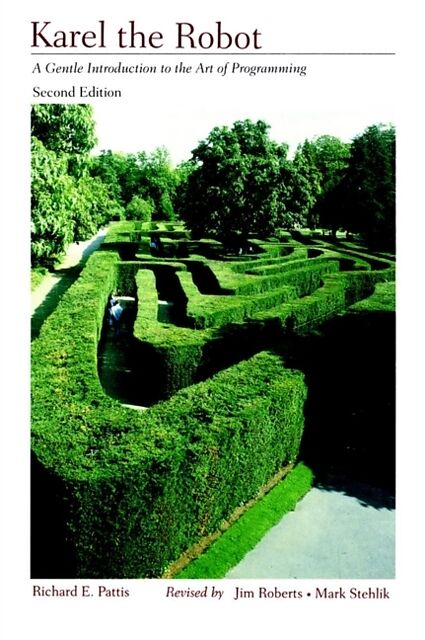Karel The Robot
Einband:
Kartonierter Einband
EAN:
9780471597254
Untertitel:
A Gentle Introduction to the Art of Programming
Genre:
Informatik
Autor:
Richard E. Pattis
Herausgeber:
John Wiley & Sons Inc
Auflage:
2 ed
Anzahl Seiten:
176
Erscheinungsdatum:
11.10.1994
ISBN:
978-0-471-59725-4
Uses a creative approach to teach the basic skills and concepts of programming quickly. This edition offers excellent insights into problem solving and program design processes. It will also improve comprehension of such computer science considerations as loop invariants and recursion. Includes 60 color line drawings.
Informationen zum Autor Richard E. Pattis is a senior lecturer at the University of California, Irvine's Donald Bren School of Information and Computer Sciences. He is the author of the Karel programming language. Jim Roberts is the author of Karel The Robot: A Gentle Introduction to the Art of Programming, 2nd Edition, published by Wiley. Klappentext Get a Fast, Clear Understanding of the Concepts and Skills of Good Programming! Karel the Robot , Second Edition Karel the Robot teaches you the fundamental concepts and skills of programming -- quickly and easily! By emphasizing logic and structure over calculation, it provides a nonthreatening introduction to the central ideas in programming -- the same ideas that apply to all computer programming languages. This widely-praised guide begins by introducing Karel, a literal-minded robot whose built-in capabilities allow him to explore his world and manipulate simple objects in it. It then introduces Karel's programming language (a block-structured language similar to Pascal), which emphasizes logical deduction and spatial reasoning rather than calculation and algebraic reasoning. Once you learn the details of Karel's deceptively simple programming language, you will soon be designing well-structured programs that instruct Karel to perform surprisingly complex tasks. Along the way, you will be absorbing sophisticated programming concepts that will enhance your programming ability! A software simulator for Karel's programming language and world is available on a wide variety of mainframes and microcomputers -- details inside. Some comments about the Second Edition "I think Karel the Robot is the greatest way to introduce programming concepts that I have seen." -- Tim Thurman , University of Kansas "I first used this language in 1981 as a student. I found it to be stimulating and challenging. In 1984 I began using Karel as a teacher. Since 1984 I have used Karel every term except one. That term represented an experiment to see how students would do without using Karel. I was not satisfied; the students performed poorly relative to those who used Karel." -- Peter Casey , Central Oregon Community College "There are no bits, no bytes or bugaboos to intimidate new minds to computers. Pattis et al. have done a wonderful job in assembling a simple little robot, giving it a little language to understand, giving it a little world to wander about in, and finally giving it to [us] so that we can all play and learn in Karel's world." -- Billibon H. Yoshimi , Columbia University Zusammenfassung Uses a creative approach to teach the basic skills and concepts of programming quickly. This edition offers excellent insights into problem solving and program design processes. It will also improve comprehension of such computer science considerations as loop invariants and recursion. Includes 60 color line drawings. Inhaltsverzeichnis Chapter 1. The Robot World 1 1.1. Karela s World 1 1.2. Karela s Capabilities 3 1.3. Tasks and Situations 4 1.4. Problem Set 6 Chapter 2. Primitive Instructions and Simple Programs 7 2.1. Changing Position 7 2.2. Handling Beepers 9 2.3. Finishing a Task 9 2.4. A Complete Program 10 2.5. Error Shutoffs 13 2.6. Programming Errors 14 2.7. Problem Set 19 Chapter 3. Extending Karela s Vocabulary 25 3.1. Creating a More Natural Programming Language 25 3.2. A Mechanism That Defines New Instructions 26 3.3. Block Structuring 27 3.4. The Meaning and Correctness of New Instructions 28 3.5. Defining New Instructions in a Program 29 3.6. Boxing: How Karel Understands a Program 32 3.7. An Ungrammatical Program 34 3.8. Tools for Designing and Writing Karel Programs 35 3.9. Advantages of Using New Instructions 53 3.10. Writing Understandable Programs 57 3.11. Problem Set 59 Chapter 4. Conditionally Executing Instructions 65 4.1. The IF/THEN ...
Klappentext
Get a Fast, Clear Understanding of the Concepts and Skills of Good Programming! Karel the Robot, Second Edition Karel the Robot teaches you the fundamental concepts and skills of programming -- quickly and easily! By emphasizing logic and structure over calculation, it provides a nonthreatening introduction to the central ideas in programming -- the same ideas that apply to all computer programming languages. This widely-praised guide begins by introducing Karel, a literal-minded robot whose built-in capabilities allow him to explore his world and manipulate simple objects in it. It then introduces Karel's programming language (a block-structured language similar to Pascal), which emphasizes logical deduction and spatial reasoning rather than calculation and algebraic reasoning. Once you learn the details of Karel's deceptively simple programming language, you will soon be designing well-structured programs that instruct Karel to perform surprisingly complex tasks. Along the way, you will be absorbing sophisticated programming concepts that will enhance your programming ability! A software simulator for Karel's programming language and world is available on a wide variety of mainframes and microcomputers -- details inside. Some comments about the Second Edition "I think Karel the Robot is the greatest way to introduce programming concepts that I have seen."
--Tim Thurman, University of Kansas "I first used this language in 1981 as a student. I found it to be stimulating and challenging. In 1984 I began using Karel as a teacher. Since 1984 I have used Karel every term except one. That term represented an experiment to see how students would do without using Karel. I was not satisfied; the students performed poorly relative to those who used Karel."
--Peter Casey, Central Oregon Community College "There are no bits, no bytes or bugaboos to intimidate new minds to computers. Pattis et al. have done a wonderful job in assembling a simple little robot, giving it a little language to understand, giving it a little world to wander about in, and finally giving it to [us] so that we can all play and learn in Karel's world."
--Billibon H. Yoshimi, Columbia University
Inhalt
The Robot World. Primitive Instructions and Simple Programs. Extending Karel's Vocabulary. Conditionally Executing Instructions. Instructions That Repeat. Advanced Techniques for Karel. Appendix. Indexes.

Leider konnten wir für diesen Artikel keine Preise ermitteln ...
billigbuch.ch sucht jetzt für Sie die besten Angebote ...
Die aktuellen Verkaufspreise von 5 Onlineshops werden in Realtime abgefragt.
Sie können das gewünschte Produkt anschliessend direkt beim Anbieter Ihrer Wahl bestellen.
Loading...
Die aktuellen Verkaufspreise von 5 Onlineshops werden in Realtime abgefragt.
Sie können das gewünschte Produkt anschliessend direkt beim Anbieter Ihrer Wahl bestellen.
| # | Onlineshop | Preis CHF | Versand CHF | Total CHF | ||
|---|---|---|---|---|---|---|
| 1 | Seller | 0.00 | 0.00 | 0.00 |
